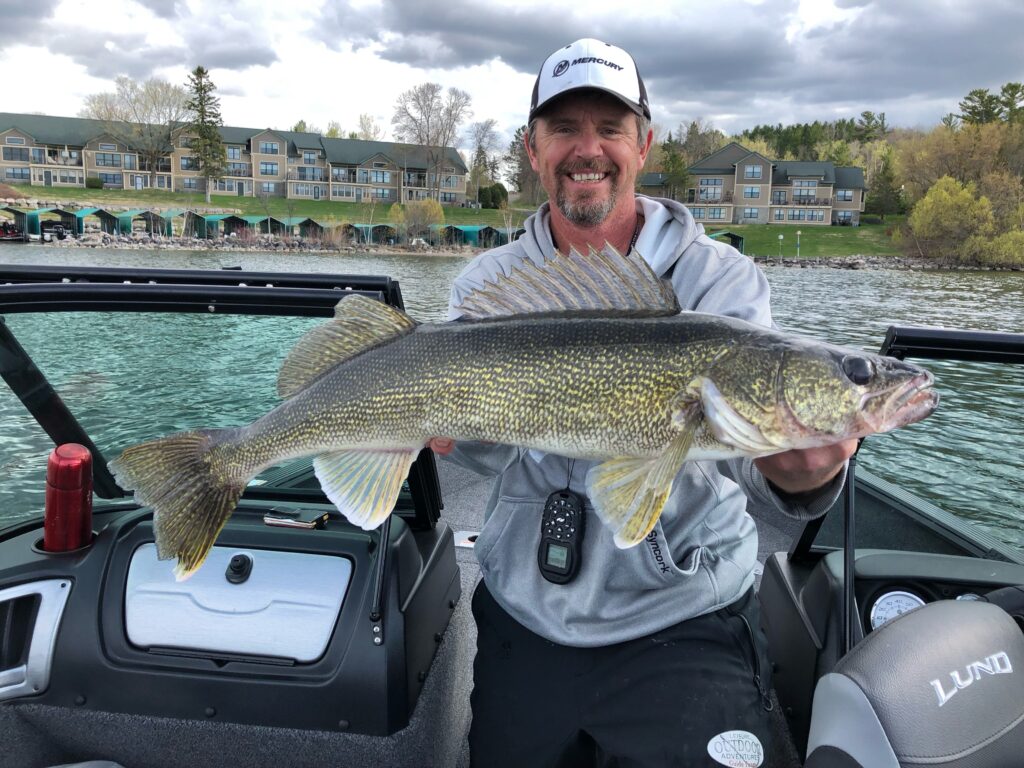
Toby Kvalevog has been guiding in northern Minnesota (Leech Lake) for several years and also has a very accomplished tournament resume. Kvalevog is regarded as a master when it comes to using chubs to catch walleye. In this Virtual Angling blog, Kvalevog lays out the details for using chubs to catch walleye in northern Minnesota.
“Probably the bigger question is when to use redtail chubs versus creek chubs,” stresses Kvalevog. According to Kvalevog, there are pronounced differences between redtail chubs and creek chubs where one specific chub type can work better depending on the situation.
Chubs in general are a high action minnow that can trigger walleye when few other presentations will. There are not many walleyes that can resist the action of a chub. Chubs can also be used to trigger the larger fish, especially when using the larger creek chubs as the larger profile and size of a chub up to nine inches can eliminate some of the smaller fish. Big walleye are also often tuned into specifically targeting larger baitfish.
Kvalevog states the obvious differences between redtail chubs and creek chubs. Creek chubs are bigger and are easier to keep alive. Creek chubs are more durable and can often be used to catch multiple fish. Red tails do seem to have much more action and struggle harder. Kvalevog prefers to use creek chubs when targeting walleye on deeper structure and deep rocks or when he wants the bigger profiled minnow for specifically targeting a bigger fish. “Over deep structure, these walleyes are often keying on bigger baitfish right now whether it be tullibee, suckers, shiners or even smelt depending on the water,” explains Kvalevog. Creek chubs that are 6-9 inches replicate this forage.
“Where I really see red tails work better than creek chubs are situations when I am using them in shallower water, especially around weeds and when the fish are keying on young of the year perch. The smaller size and increased action seem especially deadly on these weed fish,” stresses Kvalevog. Kvalevog stresses that there are situations where one particular type of chub will out fish the other. Both chub species have their own pros and cons. Creek chubs are bigger, track behind on the snell better, are more durable and easier to keep alive. Red tails are smaller often ranging between three and five inches, have more action and are much harder to keep alive.
Kvalevog has experimented a lot with rigging chubs and has started using smaller hooks like a size four live bait hook through the upper lip membrane. Traditionally, many chub anglers use a larger wide gap 1/0 hook through the upper nose which works well but when hooking chubs through the tough tissue between the nostrils, the bait doesn’t tear from the hook and the hook often sets into the chub instead of the fish. Kvalevog began using smaller hooks in the tip of the upper lip and found that he hooked up more fish especially if he needs a big bite in a tournament situation.
The standard chub rig for Kvalevog is a six-to-seven-foot snell of six-pound monofilament with a small swivel and sliding egg weight while also using six-pound mono for the main line. “I will use a ten-pound fluorocarbon snell when I am guiding if the people want to catch pike, etc. but when I need to really finesse walleye and get the most bites, I like a subtle six-pound mono like Berkley Sensation,” adds Kvalevog. Kvalevog starts with a seven-foot leader and trims it down retying knots through the day, replacing the leader when it gets down to about four feet.
Speed at which to pull chubs can vary by depth of water and you can’t do anything wrong in that the minnow will do the work but a standard speed to cover water might be around 1 mile per hour while often slowing down to a half mile per hour to let the chub work and trigger more difficult fish. Kvalevog often likes to experiment with whether the sinker is making bottom contact versus lifting the weight off bottom when going over fish on the electronics that won’t eat. Don’t be afraid to turn around and go back and forth over fish you can see and adjust the weight and how high the chub is swimming.
Besides the traditional dragging, Kvalevog will also use forward facing sonar to cast at specific fish with chubs. “I typically use a heavier weight like a ½ or 3/8th ounce egg weight and shorten up the snell. I really like the red tails for casting. I just cast at a fish or a school of fish I can see and use the boat to troll the chub through or out of the spot or open the bait and just let the chub sit in one place. Red tails below slip bobbers can also be deadly when using forward facing sonar like Active Target.
When bites get tough or when you specifically want to catch a larger fish, few presentations can compete with chubs. Kvalevog’s chub mastery is Minnesota centric with adaptations for clear water and heavy fishing pressure, but this chub program will catch big walleye through the summer and well into the fall.



